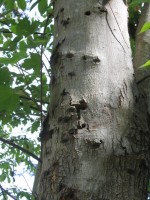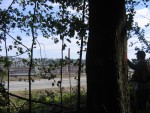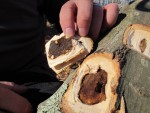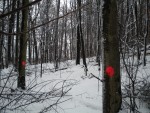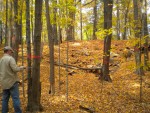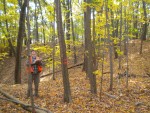PETERSHAM, Mass. (August 29, 2011) – New results from the first study of the Asian longhorned beetle (ALB) in forests shows that the invasive insect can easily spread from tree-lined city streets to neighboring forests. Successful ALB eradication efforts in Chicago, and ongoing eradication efforts in Boston, New York, and other U.S. cities have focused exclusively on urban street trees. The ongoing ALB infestation in Worcester, Mass., is the only outbreak so far that has allowed the beetle to invade nearby closed-canopy forests.
The beetle was first detected in Worcester in 2008 by a private citizen. USDA containment efforts now cover a 98-square-mile area around the city. Forests surrounding Worcester are part of a heavily wooded corridor stretching from New York into New Hampshire, Vermont, and Maine. David Orwig, a forest ecologist at the Harvard Forest and one of two lead researchers on the new study, explains, “It appears that the ALB has been in the Worcester area for at least 10 years, and, undetected, could have easily spread to even larger tracts of continuous forest.” Kevin Dodds, an entomologist from the U.S. Forest Service and the other lead researcher on the study, adds, “From our work it became apparent that ALB was readily moving through forests and attacking trees, making it a threat to forests of the region.”
On city streets, the ALB invades many different types of hardwood trees. But in forests, the beetle disproportionately attacks large maple trees. At one of the forested study sites in a suburb north of Worcester, nearly two-thirds of all the maples were infested, including red, sugar, and Norway maples. Maple trees are a vital component of New England’s iconic landscape, as well as its maple syrup industry. Red maples, the study shows, are particularly vulnerable to infestation. Red maples are widespread in New England and central to the region’s fall foliage tourism industry, which attracts over 1 million visitors annually to New England and generates $1 billion in revenue. According to Orwig, “If the ALB continues to spread outside Worcester, the abundance of red maples could provide a pathway for its dispersal throughout New England and other parts of eastern North America.”
According to the study, which appeared in the Canadian Journal of Forest Research on August 29, the Worcester ALB outbreak is the largest to date in North America in terms of infested trees found (more than 19,600), trees searched (more than 1,100,000), trees removed (more than 29,000), and quarantine area size. The ALB eradication efforts in these stands have involved tree harvest and consequently have led to shifts in forest composition from maple to oak, which may have cascading effects on soil processes and ecosystem function. Orwig notes that a long view is critical to studying and forecasting the impacts of ALB and other invasive pests. “The duration of the current infestation is unknown, but it is likely to continue for at least several more years. Only through a long-term approach and funding can we begin to evaluate the impacts of how ecosystems are impacted over decades and longer.”
TheHarvard Forest, founded in 1907 and located in Petersham, is Harvard University's center for research and education in forestry and ecology, and a Long-Term Ecological Research (LTER) site funded by the National Science Foundation. Its 3,500 acre property is one of the oldest and most intensively studied research forests in the U.S. Open to the public year-round, the site includes educational and research facilities, a museum, and recreation trails.
For the full paper, see “An Invasive Forest Pest Invades Natural Environments: Asian Longhorned Beetle in Northeastern U.S. Hardwood Forests.” Canadian Journal of Forest Research, Aug. 29, 2011.

 Enlarge this image
Enlarge this image